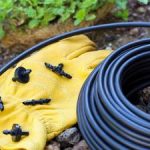Toilet water should stay in the bowl and not be siphoned back into your kitchen or drinking water. The same goes for your irrigation system – you don’t want water that’s been sitting on your lawn (and possibly contaminated by Fifi or Fido) flowing back into your home through the kitchen tap. Water finds the path of least resistance and that’s when a backflow situation can occur.
First it helps to know what backflow is. The term is used to describe the backward flow of water. Residentially speaking, backflow occurs when water contaminated with dirt, chemicals or other foreign substances flows from a cross connection back into your home. Cross connections include irrigation systems, hoses submerged in swimming pools or buckets, hoses connected to faucets in laundry sinks or tubs, or hoses attached to lawn chemical sprayers. These are some of the most common ways backflow occurs.
The simplest and most effective way to prevent a backflow situation is to provide an air gap, or space between a device that opens to a plumbing system (like a valve or faucet) to an area where water can collect or pool.
If you have an irrigation system, it must have a backflow preventer assembly, usually located in a box near your water meter. City ordinance requires all residential and commercial irrigation systems be equipped with this device and checked annually. Just as important as making sure your irrigation system has a backflow prevention device is having the assembly tested every year – including commercial properties – by a Texas-licensed backflow preventer assembly tester.
Don’t have an irrigation system? Help prevent backflow by installing inexpensive vacuum breakers on the garden hose connections outside your home. Most home improvement stores keep vacuum breakers in stock.
For more information and other resources on backflow prevention, visit the American Backflow Prevention Association (San Antonio chapter) Web site.




